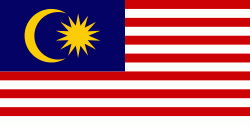Perak
 |
 |
The discovery of an ancient skeleton in Perak supplied missing information on the migration of Homo sapiens from mainland Asia through Southeast Asia to the Australian continent. Known as Perak Man, the skeleton is dated at around 10,000 years old. An early Hindu or Buddhist kingdom, followed by several other minor kingdoms, existed before the arrival of Islam. By 1528, a Muslim sultanate began to emerge in Perak, out of the remnants of the Malaccan Sultanate. Although able to resist Siamese occupation for more than two hundred years, the Sultanate was partly controlled by the Sumatra-based Aceh Sultanate. This was particularly the case after the Aceh lineage took over the royal succession. With the arrival of the Dutch East India Company (VOC), and the VOC's increasing conflicts with Aceh, Perak began to distance itself from Acehnese control. The presence of the English East India Company (EIC) in the nearby Straits Settlements of Penang provided additional protection for the state, with further Siamese attempts to conquer Perak thwarted by British expeditionary forces.
The Anglo-Dutch Treaty of 1824 was signed to prevent further conflict between the British and the Dutch. It enabled the British to expand their control in the Malay Peninsula without interference from other foreign powers. The 1874 Pangkor Treaty provided for direct British intervention, with Perak appointing a British Resident. Following Perak's subsequent absorption into the Federated Malay States (FMS), the British reformed administration of the sultanate through a new style of government, actively promoting a market-driven economy and maintaining law and order while combatting the slavery widely practised across Perak at the time. The three-year Japanese occupation in World War II halted further progress. After the war, Perak became part of the temporary Malayan Union, before being absorbed into the Federation of Malaya. It gained full independence through the Federation, which subsequently became Malaysia on 16 September 1963.
Perak is ethnically, culturally and linguistically diverse. The state is known for several traditional dances: bubu, dabus, and labu sayong, the latter name also referring to Perak's unique traditional pottery. The head of state is the Sultan of Perak, and the head of government is the Menteri Besar. Government is closely modelled on the Westminster parliamentary system, with the state administration divided into administrative districts. Islam is the state religion, and other religions may be practised freely. Malay and English are recognised as the official languages of Perak. The economy is mainly based on services and manufacturing.
There are many theories about the origin of the name Perak. Although not used until after 1529, the most popular etymology is "silver" (in Malay: perak). This is associated with tin mining from the state's large mineral deposits, reflecting the Perak's position as one of the world's largest sources of tin. The first Islamic kingdom established in the state was of the lineage of the Sultanate of Malacca. Some local historians have suggested that Perak was named after Malacca's bendahara, Tun Perak. In maps prior to 1561, the area is marked as Perat. Other historians believe that the name Perak derives from the Malay phrase "kilatan ikan dalam air" (the glimmer of fish in water), which looks like silver. Perak has been translated into Arabic as (Dār al-Riḍwān), "abode of grace".
Map - Perak
Map
Country - Malaysia
 |
 |
| Flag of Malaysia | |
Malaysia has its origins in the Malay kingdoms, which, from the 18th century on, became subject to the British Empire, along with the British Straits Settlements protectorate. Peninsular Malaysia was unified as the Malayan Union in 1946. Malaya was restructured as the Federation of Malaya in 1948 and achieved independence on 31 August 1957. The independent Malaya united with the then British crown colonies of North Borneo, Sarawak, and Singapore on 16 September 1963 to become Malaysia. In August 1965, Singapore was expelled from the federation and became a separate independent country.
Currency / Language
| ISO | Currency | Symbol | Significant figures |
|---|---|---|---|
| MYR | Malaysian ringgit | RM | 2 |
| ISO | Language |
|---|---|
| ZH | Chinese language |
| EN | English language |
| MS | Malay language |
| ML | Malayalam language |
| PA | Panjabi language |
| TA | Tamil language |
| TE | Telugu language |
| TH | Thai language |















